Mark Scott Smith's Blog: Enemy in the Mirror, page 87
October 2, 2017
Japan Surrenders – September 2, 1945
After the bombing of Hiroshima, some members of Japan’s supreme war council favored acceptance of the Potsdam Declaration, but the majority resisted unconditional surrender. Things grew worse when the USSR declared war against Japan. Then, a second atomic bomb was dropped on Nagasaki.
About midnight on August 9, Emperor Hirohito convened the supreme war council. After a long, emotional debate, the council obeyed his order to accept the Allied peace terms.
On August 12 the United States replied: “The authority of the emperor and the Japanese government to rule the state shall be subject to the Supreme Commander of the Allied Powers.” After two days of debate within the council, Hirohito ignored the nuances in the text and ordered the Japanese government to prepare a surrender message.
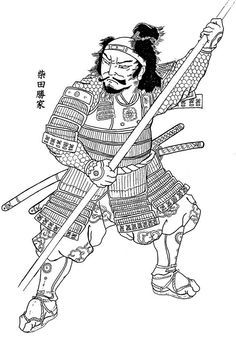
During the night of August 15, 1945 a military coup, the Kyūjō incident was attempted by a faction led by Major Kenji Hatanaka. The rebels seized control of the imperial palace and burned Prime Minister Suzuki’s residence. Shortly after dawn the coup was crushed and the leaders committed suicide.
At noon, Emperor Hirohito went on national radio for the first time to announce the Japanese surrender. In court language, unfamiliar to his subjects, he said: “We have resolved to pave the way for a grand peace for all the generations to come by enduring the unendurable and suffering what is insufferable.”

終戦の詔書 Emperor Hirohito Rescript at WWII end, English Translation

Japanese citizens in front of the Imperial palace on August 15, 1942. (dailymail.co.uk)
President Truman appointed General Douglas MacArthur to head the Allied occupation of Japan as Supreme Commander of the Allied Powers. The site of Japan’s formal surrender on September 2, 1942, was the seasoned battleship USS Missouri, anchored in Tokyo Bay along with 250 other Allied warships.

THE JAPANESE SURRENDER DOCUMENTS – WWII:
(1) – We…agree that Japan shall be given an opportunity to end this war.
(2) – …determination of all the Allied Nations to prosecute the war against Japan until she ceases to resist.
(3) -The result of the futile and senseless German resistance to the might of the aroused free peoples of the world stands forth in awful clarity as an example to the people of Japan…
(4) -The time has come for Japan to decide whether she will continue…or whether she will follow the path of reason.
(5) Following are our terms. We will not deviate from them. There are no alternatives. We shall brook no delay.
(6) There must be eliminated for all time the authority and influence of those who have deceived and misled the people of Japan into embarking on world conquest, for we insist that a new order of peace, security and justice will be impossible until irresponsible militarism is driven from the world.
(7) Until such a new order is established AND until there is convincing proof that Japan’s war-making power is destroyed, points in Japanese territory to be designated by the Allies shall be occupied to secure the achievement of the basic objectives we are here setting forth.
(8) The terms of the Cairo Declaration shall be carried out and Japanese sovereignty shall be limited to the islands of Honshu, Hokkaido, Kyushu, Shikoku, and such minor islands as we determine.
(9) The Japanese military forces, after being completely disarmed, shall be permitted to return to their homes with the opportunity to lead peaceful and productive lives.
(10) We don not intend that the Japanese shall be enslaved as a race or destroyed as a nation, but stern justice shall be meted out to all war criminals, including those who have visited cruelties upon our prisoners. The Japanese Government shall remove all obstacles to the revival and strengthening of democratic tendencies among the Japanese people. Freedom of speech, of religion and of thought, as well as respect for the fundamental human rights, shall be established.
(11) Japan shall be permitted to maintain such industries as will sustain her economy and permit the exaction of just reparations in kind, but not those which would enable her to rearm for war. To this end, access to, as distinguished from control of, raw materials shall be permitted. Eventual Japanese participation in world trade relations shall be permitted.
(12) The occupying forces of the Allies shall be withdrawn from Japan as soon as these objectives have been accomplished and there has been established, in accordance with the freely expressed will of the Japanese people, a peacefully inclined and responsible Government.
(13) We call upon the Government of Japan to proclaim now the unconditional surrender of all Japanese armed forces, and to provide proper and adequate assurances of their good faith in such action. The alternative for Japan is prompt and utter destruction.
The post Japan Surrenders – September 2, 1945 appeared first on Enemy in the Mirror.
September 28, 2017
Nagasaki – August 9, 1945
President Harry Truman approved but did not specify the dates for use of atomic bombs.The Target Committee identified the targets and determined the best opportunities for attack based on logistics and weather. After the bombing of Hiroshima produced no Japanese response, the decision was made to proceed with plans to bomb Kokura.
Nagasaki was a seaport in southern Japan that produced military ordnance, ships, equipment and war materials. Most buildings in the city of 263,000 people were built with timber in old-fashioned Japanese style. Because its geography made it difficult to locate at night, the city had not been firebombed.

In the early hours of August 9, 1945, a B-29 named Bockscar, flown by Major Charles W. Sweeney, carried the 10,000 pound atomic bomb Fat Man, toward its primary target Kokura with Nagasaki as the secondary option. With clouds and smoke from a nearby air raid obscuring the aiming site at Kokura, Major Sweeney made three unsuccessful runs over the city before heading for the secondary target, Nagasaki.

At 11:01, a break in the clouds over Nagasaki allowed Bockscar’s bombardier to sight the target. The Fat Man weapon, containing a core of plutonium, exploded 47 seconds later at 1,650 ft over the city’s industrial valley. Because the bomb dropped almost two miles northwest of the intended hypocenter, a major portion of the city was protected by the intervening hills.
With the release of ~21 Kilotons of energy, the temperature within the fireball reached ~7,050 °F. Winds were estimated to be >620 mph.
Although casualty estimates for immediate death varied, at least 35,000–40,000 people were killed and 60,000 others injured. Following the explosion, more people died from delayed effects of the bomb. By the end of 1945, total deaths due to the attack are variably estimated to be 39,000-80,000.
The touching 2015 Japanese film Nagasaki: Memories of My Son is about a widow who lost her husband and eldest son in the war and her youngest son Koji during the bombing of Nagasaki. Living alone with only her midwifery to keep her occupied, she is visited by an apparition of Koji.
Read the New Yorker article: Nagasaki: The Last Bomb
The post Nagasaki – August 9, 1945 appeared first on Enemy in the Mirror.
September 25, 2017
Operation August Storm 1945
On August 8, 1945, after refusing to mediate a Japanese surrender with the United States and its allies, the USSR declared war on Japan.
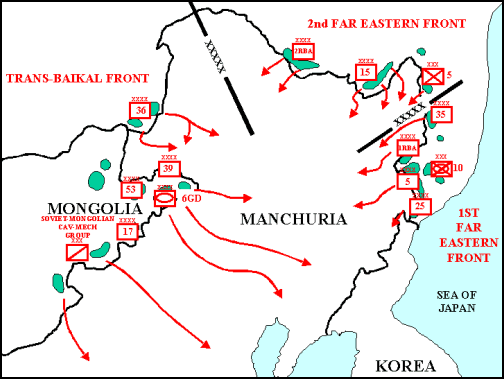
On August 9, 1945, Russian troops invaded the Japanese puppet state of Manchukuo in Operation August Storm.
On August 14, 1945 a Soviet armored division and some Chinese troops massacred ~1500 Japanese civilians near Gegenmiao Manchuria. Japanese refugees (mostly women and children) were reportedly shot, run over by tanks or trucks or bayoneted after they had raised a white flag in surrender.
Soviet and Mongolian troops soon ended Japanese control of Manchukuo, Mengjiang (inner Mongolia), South Sakhalin Island (Karafuto), and the Chishima (Kuril) Islands and northern Korea.

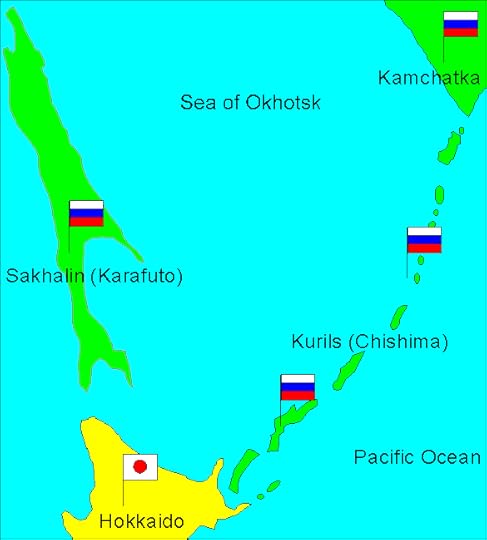
The post Operation August Storm 1945 appeared first on Enemy in the Mirror.
September 21, 2017
Hiroshima – August 6, 1945
In April-July 1945 Japanese forces inflicted Allied casualties totaling nearly half those suffered in three full years of war in the Pacific. In late July, Japan’s militarist government rejected the Potsdam Declaration demanding unconditional surrender or total destruction. For the new U.S. president Harry S. Truman, the Empire of Japan appeared ever more deadly when faced with defeat.
General Douglas MacArthur, along with General Dwight Eisenhower, some Manhattan Project scientists and senior U.S. military commanders recommended a continuation of conventional bombing followed by a massive invasion of mainland Japan. Informed that the invasion would cost up to a million U.S. Casualties, President Truman opted to use the atomic bomb, hoping to conclude the war swiftly.
Hiroshima, a manufacturing center of some 350,000 people located about 500 miles west of Tokyo, was selected as the first target.




Hiroshima before the atomic bombing

On Tinian island, a ~ 9,000-pound uranium-235 bomb was loaded aboard a modified B-29 bomber named Enola Gay (named after the mother of its pilot, USAAF Colonel Paul Tibbets.

At 08:45 in the morning on August 6, 1945, the Enola Gay dropped “Little Boy,” the world’s first deployed atomic bomb over the city of Hiroshima.

Parachuting down, the bomb exploded 2,000 feet above the city with a blast equal to 12-15,000 tons of TNT. 90% of the city (five square miles) was destroyed and 80,000 people were killed instantly; tens of thousands died later from radiation exposure.

A Reporter at Large New Yorker Magazine ~ August 31, 1946 Issue
Hiroshima – Open link to read the entire story
By John Hersey

City Ravaged by Flames – Sadako Kurihara (1912-2005)
Amid rubble /ravaged by flames/the last
moments /of thousands: /what sadness! /
Thousands of people,/tens of thousands:
/lost/the instant/the bomb exploded./
silent, all sorrows/unspoken,/city of
rubble/ravaged by flames:/autumn rain falls.

The post Hiroshima – August 6, 1945 appeared first on Enemy in the Mirror.
September 18, 2017
USS Indianapolis July 1945
Unfortunately, this clunky film doesn’t do justice to the fate of the USS Indianapolis crewmen and or its scapegoated captain.
On July 30, 1945 the USS Indianapolis, after delivering A-Bomb components to Tinian Island for the atomic bomb used against Hiroshima, was torpedoed by a Japanese submarine in the Philippine Sea.

The Indianapolis sank in 12 minutes. Three hundred of 1,196 crewmen went down with the ship. The remainder were left floating in shark-infested waters with no lifeboats, most without food or water.

The U.S. Navy failed to notice the ship was missing, and when it was finally spotted by a routine air patrol four days later, only 316 men were still alive. The remainder had succumbed to exposure, dehydration, saltwater poisoning or shark attacks. It was the worst naval disaster in US History.

Despite the recommendation of the Commander in Chief, Pacific Ocean Areas, Admiral Chester Nimitz that the ship’s Captain, Charles Butler McVay III, was at worst guilty of an error in judgment, but not gross negligence, naval authorities in Washington, including Secretary of the Navy James Forrestal and Admiral Ernest King, Chief of Naval Operations ordered court-martial proceedings against McVay. A veteran of the naval battles at Iwo Jima and Okinawa, Captain McVay was subsequently convicted of “hazarding his ship by failing to zigzag,” despite strong evidence the Navy had carelessly placed the ship in harm’s way, failed to note its absence, and testimony that zigzagging would have made no difference.
In 1946, in response to a request from Admiral Nimitz, who had become Chief of Naval Operations, Secretary Forrestal remitted McVay’s sentence and restored him to duty. McVay served in the New Orleans Naval District until retirement in 1949 with the rank of Rear Admiral.
In 2000, the United States Congress passed a resolution exonerating McVay for the loss of the USS Indianapolis.
In 1968 McVay killed himself with his service pistol while holding a toy sailor he had received as a boy for a good luck charm.
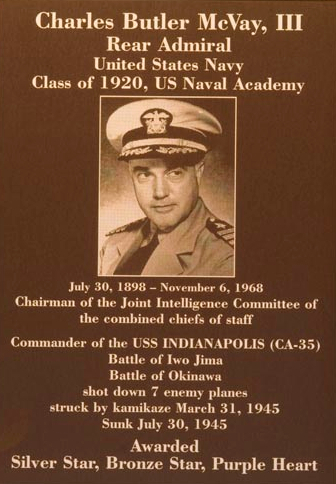
The post USS Indianapolis July 1945 appeared first on Enemy in the Mirror.
September 14, 2017
Final Strikes on Japan- July 1945
Instead of battleships, fleet carriers became the primary striking force of the U.S. Navy in late 1944. The Fast Carrier Task Force operated in Pacific waters from January 1944 until the end of WWII in August 1945.
After the conquest of Okinawa, the next invasion was scheduled to be in October 1945 with Operation Olympic, the invasion of Kyushu.
While the U.S. Navy 3rd Fleet returned to Leyte to resupply and rest, a series of fast carriers operations against industrial plants, infrastructure and airfields from Hokkaido to Kyushu were planned.

In July 1945, carrier-launched air raids attacked the cities of Aomori and Hakodate and severed the car and rail ferry link between Honshu and Hokkaido. Eight of the twelve ferries carrying Hokkaido’s coal supply to the vital industries on Honshu were sunk, two were heavily damaged, and two beached. 400 passengers were killed.



Excerpt from my book Enemy in the Mirror: Love and Fury in the Pacific War
Hakodate, Hokkaido ~ July 1945
…A little after four o’clock Fumiko and Miyoko boarded the tram back to the harbor. As was the custom, most of the passengers were sitting quietly, not making eye contact. Miyoko stood and offered her seat to an elderly woman carrying a large bundle. Fumiko looked about the car discreetly. Several young men in summer white uniforms were quietly conversing in the rear. A young child with half-closed eyes leaned against her expressionless mother.
Just past the Red Cross Hospital, the tram suddenly lurched to a stop. For a moment, the startled passengers looked at one another quizzically, then the air raid sirens began to moan. The conductor opened the doors and calmly directed everyone to get off the tram. Knowing that rail lines were often the target of marauding airplanes, the passengers quickly ran away from the tracks.
Fumiko and Miyoko ran across the street as flashes of light and the sound of explosions came from the harbor. There was no air raid shelter in sight, so they huddled against the wall of a concrete building. Cars and trucks were abandoned by the roadside and a lone bicyclist peddled frantically up the street. The continuous drone of aircraft engines was interspersed with decrescendo whistling, muffled booms and machine gun fire. Clouds of black smoke flecked with flashing red ash were beginning to billow over the western part of the city.
Fumiko drew the terrified Miyoko to her and squinted into the distance. A gray haze permeated with the smell of petroleum, burning wood and cordite was advancing toward them. Then a black shadow, emitting hyphenated ribbons of white light, broke out of the swirling cloud of smoke. Streaking low over the rooftops, it soon became a silvery blue color. White stars in blue circles were stenciled on its wings and fuselage. From photographs she’d seen in the newspaper, Fumiko recognized the Grumman Avenger. Bullets ricocheted off the pavement and riddled the abandoned tram in the middle of the street. Fumiko could see the crew of the torpedo bomber as it flew low only a hundred meters away. How uncanny! She could almost reach out and touch the enemy. The plane banked and roared off, rapidly becoming a speck in the sky.
Soon dozens of airplanes were attacking the railheads, wharves and dockyards of Hakodate with bombs, rockets and machine gunfire. Only a few dilapidated Zeros rose to challenge the swift and agile American dive bombers as they maneuvered freely through ineffective fire from the antiaircraft batteries in the harbor. After several runs, the sleek attack bombers abruptly flew back out to sea leaving the harbor in flames. In one brief surgical strike, the vital link transporting coal from Hokkaido to the dependent industries of Honshu had been severed…
The post Final Strikes on Japan- July 1945 appeared first on Enemy in the Mirror.
September 11, 2017
German POWs 1945

Unlike the treatment of German POWs in the USA, the Allied treatment of German military prisoners in Europe at the end of the war is quite controversial. With titles like Eisenhower’s Death Camps, The Real Holocaust, The Last Dirty Secret of WWII and Eisenhower Mass Murderer, many online posts and videos claim the Allies, under General Dwight Eisenhower‘s direction, intentionally mistreated and starved ~ one million German prisoners of war after Germany’s surrender in 1945.
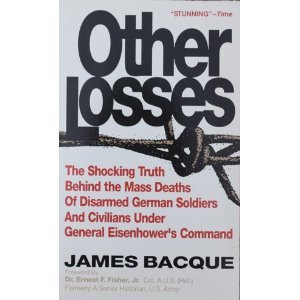
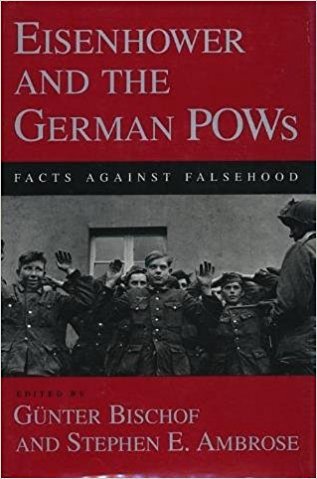
Other Losses published by Canadian writer James Bacque in 1989, claims General Eisenhower intentionally caused the deaths by starvation or exposure of ~a million German prisoners of war in internment camps following the surrender of Germany in 1945.
A perhaps more circumspect view, published by the historian Stephen Ambrose in the New York Times, acknowledges that General Eisenhower hated the Nazis (particularly after viewing the horror of their concentration camps) and there was indeed widespread mistreatment of German prisoners in the spring and summer of 1945. Ambrose states: “Men were beaten, denied water, forced to live in open camps without shelter, given inadequate food rations and inadequate medical care.”
Food shortage throughout Western Germany was a serious problem for the occupation forces.
>3.5 – 5 million German soldiers became prisoners
>two million slave laborers were liberated
millions of civilians fled from the East to West
Although required by the Geneva Convention, Eisenhower maintained the Allies could not afford to feed German prisoners at the same level as U.S. troops. Therefore the prisoners were assigned the designation of “Disarmed Enemy Forces” instead of POWs. Field commanders were ordered not to feed the D.E.F.’s more than German civilians.
In the 3-4 months after the end of WWII, thousands of people died of hunger, exposure, and neglect; and hundreds of thousands barely survived. Millions of soldiers were still imprisoned for many months after the war was over.

The post German POWs 1945 appeared first on Enemy in the Mirror.
September 7, 2017
B-25 Strikes Empire State – July 1945
A U.S. Army Air Force B-25 Mitchell bomber crashed into the Empire State Building on Saturday July 28, 1945. Fourteen people were killed.
Flying from New Bedford, Massachusetts, to LaGuardia Airport in New York City, with two pilots and a passenger aboard, the B-25 encountered heavy fog over the New York metropolitan area and was instructed to land at Newark Airport instead.
The altered flight plan crossed over Manhattan; and the crew was specifically warned that the Empire State Building was not visible. Seeking improved visibility, the B-25 flew relatively low. Seeing the Chrysler Building in midtown, the pilot swerved to avoid the building but flew straight into the north side of the Empire State Building, near the 79th floor.
The plane’s jet fuel exploded, sending flames all the way down to the 75th floor and leaving an 18 x 20 foot hole the in the building’s side. One engine from the B-25 crashed through the building, landing in a penthouse across the street. Other debris struck nearby buildings. The second engine snapped an elevator cable – an emergency auto brake saved a woman from crashing to her death.
Because it was the weekend, relatively few workers were in the building. In addition to the B-25 pilot, copilot and passenger, eleven office workers died by fire or violent ejection from the building by the the crash.
The post B-25 Strikes Empire State – July 1945 appeared first on Enemy in the Mirror.
September 4, 2017
Potsdam Conference – July 1945
In July 1945, USSR Premier Joseph Stalin, the new American president Harry S. Truman, and Prime Minister Winston Churchill of Great Britain met in Potsdam Germany in the last Big Three meeting of WWII .

At Potsdam, the Big Three leaders demanded unconditional surrender from Japan, although privately they agreed to allow the emperor to remain in place as a figurehead.
An Allied Control Council was established for military administration of Germany. Nazi institutions that controlled the economy were decentralized, and it was agreed that the entire German nation would be treated as a single economic unit.
War criminals would be brought to trial.
The USSR was allowed to define the Polish-German border, transferring land east of the Oder and Neisse rivers from Germany to Poland.
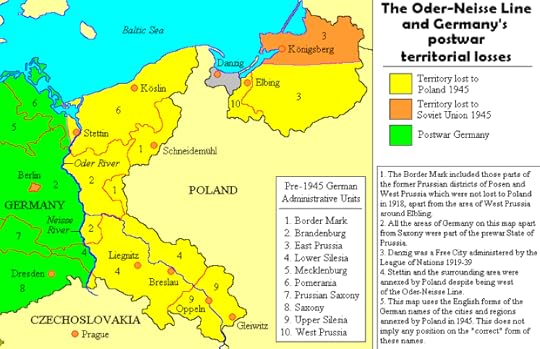
Regarding reparations, the Big Three reached a compromise, based on an exchange of capital equipment from the Western zone for raw materials from the East. Unfortunately, resolution of this issue set the precedent of managing the German economy by zone rather than as a whole.
Truman received word of a successful American atomic bomb test soon after he arrived at Potsdam. He told Churchill the news but only mentioned ‘a new weapon’ to Stalin, continuing to solicit Soviet assistance against Japan.
The post Potsdam Conference – July 1945 appeared first on Enemy in the Mirror.
August 31, 2017
Under the Sand – 1945

From 1940-1943, the Danish government pursued a course of cautious cooperation with the occupying forces of Nazi Germany. However, in 1943, with increased turbulence and sabotage by the underground resistance movement, the Germans imposed a state of emergency and disbanded the government. Many arrests and executions followed. By 1945 Denmark was besieged by shortages of goods, generalized fear and unrest. At the end of the war, Danes seethed with anger against Germans.
During its occupation of Denmark, Nazi Germany planted hundreds of thousands of land mines on the west coast beaches of Denmark. Although it violated the Geneva Convention prohibition against making prisoners of war do dangerous work, at war’s end >2000 German prisoners were forced to deactivate them. Many of them died.


The joint Danish-German film Land of Mine (Danish title: Under Sandet), directed by Martin Zandvliet, depicts the ethical tension between justice and vengeance in a taut, powerful drama about a team of teenage German POWs under the strict supervision of a bitter, Danish Non-Commissioned officer, filled with rage at his country’s former conquerors.
The film is shocking, moving, violent, tender, heart-breaking and powerful.
The post Under the Sand – 1945 appeared first on Enemy in the Mirror.
Enemy in the Mirror
I began by posting events around the turn This website www.enemyinmirror.com explores the consciousness, diplomacy, emotion, prejudice and psychology of 20th Century America and her enemies in wartime.
I began by posting events around the turn of the 20th century as I was researching my first novel about the Pacific War. I continued through WWII for my second novel about the Battle of the Atlantic. Now I am beginning to look at the Cold War as I gather information for my next novel about the Korean War. ...more
- Mark Scott Smith's profile
- 7 followers



